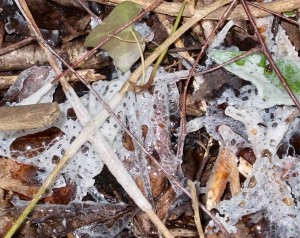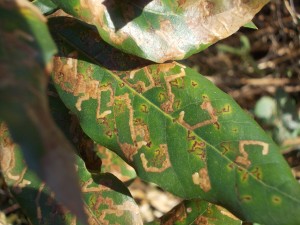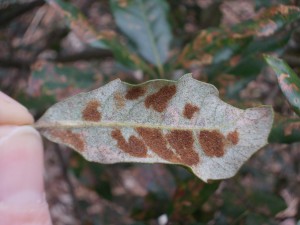
After the brief heatwave it feels like March again. In the Gunnersbury Triangle nature reserve, willow buds are starting to open but only the evergreen trees like the native yew and holly, and the invasive holm oak (from the Mediterranean) are in leaf. Not much to see, then? Not a bit of it.
In the leaf litter under the forest canopy, a large and handsome white slime mould was spread out, draped over some twigs in a fine shiny film. In detail its surface seems almost fractal, full of rounded holes at different scales like a Sierpinski Triangle if you know what one of those is. The individual cells – I’d almost call them animals – of the slime mould signal to each other with a chemical (AMP), which causes them to aggregate; they slowly ooze along like amoebae, eventually forming fruiting bodies rather like small fungi. It’s an extraordinary process, and in an odd way quite beautiful.

Meanwhile, the large holm oak by the picnic meadow looks utterly extraordinary, something like the horse chestnuts that have been attacked by plagues of leaf miner moths. Almost every leaf of the holm oak is scarred yellow and brown with the wandering trails of the moth caterpillars, making the tree look multicoloured and very badly battered. This is probably the work of Ectoedemia heringiella, according to the RHS.

Many of the leaves also have squarish brown furry patches (a filzgall or erineum ) on the underside; the leaves are naturally fluffy, with a tiny gall mite, Aceria ilicis, causing overgrowth; the thickened, darker hairs are too tough for the insect to eat, so the plant’s reaction works as a defence.
And that is not all; there are also a fair number of much larger pupae, probably of another moth species, wrapped in partly-rolled leaves, tied up with silk threads. We used to think of the holm oak as a useless non-native species with no pests or predators: not any longer, it seems, though at least the leaf-miner is a recent arrival itself.
Down at the pond, there are masses of frogspawn; at least a dozen large frogs, with at least four mating pairs, were responsible. When we came over the mound they must have seen us as there was a remarkable amount of splashing; even in amplexus they are capable of emergency diving: this is just as well, as much of the weed and reed has been cut during the winter.
